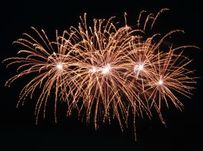Hogmanay - a history
Friday, 27th November 2009

Hogmanay is the name for the New Year’s celebrations in Scotland, which normally start on 31st December and continue until the following morning, or until 2nd January in some cases.
Both 1st and 2nd January are Bank Holidays in Scotland, which gives people a chance to recover from the Hogmanay celebrations.
The origins of the word Hogmanay are uncertain. Some believe that it arrived in Scotland during the 16th century and comes from the Old French word aguillanneuf, which means a New Year’s gift or New Year’s Eve, via the word hoguinané, which comes from Norman. Others have suggested that it comes from Scottish Gaelic, Old English, Old Norse, Manx, Dutch, Greek or Spanish.
The roots of Hogmanay go back to winter solstice celebrations, which were possibly introduced to Scotland by the Vikings, who called them Yule. These customs became the part of Twelve Days of Christmas (25th December – 6th January), which are also known as the “Daft Days” in Scotland. Christmas itself was in fact rarely celebrated in Scotland from the late 17th century until the mid-20th century because the Protestant Church did not approve of this Catholic feast. As a result Hogmanay became the main time for parties, exchanging presents and other festivities.
There are a number of customs associated with Hogmanay, some of which are observed throughout Scotland, while others are only found in particular areas. The best-known custom is ‘first-footing’, which is thought to bring good luck and involves the first person to visit their friends or neighbours after midnight on New Year’s Eve bringing coal, whisky or other drinks, salt, shortbread, black bun and other symbolic gifts.
Traditionally first footers are tall, dark-haired, handsome men, and in some areas first footing by women or fair-haired men is thought to be unlucky, as is first footing by doctors, priests or grave diggers. They offer everyone they meet a dram of whisky or of other drinks they have, and propose toasts such as ‘A guid New Year to ane an a’ and mony may you see’ (A good New Year to one and all and many may you see). Traditionally they also place their lump of coal on their host’s fire, and can claim a kiss from every lady they meet.
Other traditions include cleaning houses on 31st December and taking out the ashes from the fire; clearing debts before the bells ring for midnight. Singing Auld Lang Syne just after midnight.
Hogmanay celebrations in Edinburgh are widely regarded to form one of the biggest and best parties in the whole of Europe, and are not for the faint-hearted! Spending New Year’s Eve in Edinburgh would be a truly unforgettable experience…
More about English courses in Edinburgh
Tags: english, spanish, french, new year, christmas, edinburgh, scotland, new years eve, hogmanay
Posted by Simon Ager under Experience Cultures, Food and Drink,
Permalink
